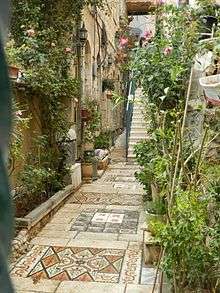Musrara, Jerusalem

Musrara (Arabic: مصرارة, Hebrew: מוסררה) also known by its Hebrew name, Morasha (Hebrew: מורשה)[1] is a neighborhood in Jerusalem. It is bordered by Meah Shearim and Beit Yisrael on the north, the Old City on the south and east, and the Russian Compound and Kikar Safra to the west.
History
Musrara was founded by upper class Christian Arab residents during the late 19th century, as a part of the "departure from the walls," during which people began living outside the Old City of Jerusalem. During the Israeli War of Independence, the Arab residents fled during the fighting or were expelled and not permitted to return to their homes. Musrara remained on the Israeli side of the border between Israel and Jordan.[2] In Roman times, the area was within the city walls of ancient Jerusalem.
During the early days of Israeli statehood, there was an extreme shortage of housing for the thousands of olim (immigrants) who flooded to Jerusalem. As a result, the Ministry of Housing decided to populate the previously Arab houses with olim from North African countries.[2] Due to its proximity to the new border, the residents of Musrara were exposed to daily attacks from Jordanian snipers stationed along the border, who did their utmost to disrupt the lives of the residents.[2] This new reality became routine until the reunification of Jerusalem after the Six Day War in 1967.
There are a number of prominent Christian institutions in Musrara, including the Notre Dame Hostel, the Church of Saint Paul, the French Hospice, and the Romanian Church.
In 1971, young, second-generation Mizrahi Jews from the neighborhood founded the Israeli Black Panthers, a protest movement against the perceived injustice and discrimination by the government against them. The rage quickly spread from Musrara to all areas inhabited by poor Mizrahi Jews, and eventually evolved into a political movement.
Musrara's strategic location between the Hareidi and religious neighborhoods to the north and the secular neighborhoods to the west has contributed to its diverse population. Over the last decade some have advocated to prevent the neighborhood from becoming more Hareidi, a process which has since slowed considerably.
Today, Musrara is home to about 4,500 people.[2]
Architecture
Musrara's built environment is a living testimony to its diversity – and that of Jerusalem in general – over the past 130 years. Examples of the various styles of architecture popular during this period can be found there. They can be divided into three general periods:
The first phase was the Arab phase, in which large, luxurious mansions were built by wealthy Arabs attempting to escape the overcrowding in the Old City during the late 19th century. These houses have grand entrances, beautiful masonry and shingled roofs.
The second phase began with the War of Independence. In the ensuing upheaval and unsettled conditions that arose along the unpeaceful new border with Jordan, houses were abandoned and new residents struggled. The neighborhood scene was one of unemployment, poverty and neglect. Conditions contributed to the rise of the Israeli Black Panther movement among new olim (Jewish immigrants) from North Africa. This phase lasted through the 1970s.
The third period, beginning in the 1980s, saw increased activity as a result of a Jerusalem Municipality program to improve the neighborhood's appearance. Development regulations were adopted that were intended to restore the neighborhood's former glory. Renovations were subsequently completed in the style of the historic Arab structures. In many buildings, though, a clear line can be seen between lower floors, built in the historic Arab style, and upper storeys built in the unadorned functional style of modern multistorey buildings. These lines reflect the decisions of real estate developers who, in the interest of cost savings, did not want to maintain the more expensive style of traditional facades on upper levels.
Cultural influence
Musrara currently serves as an important cultural center, with a number of museums and centers of the arts. These include the Naggar School of Photography, known simply as "Musrara," the Ma'ale school of film, the School of Eastern Music, the Jerusalem Municipality's art center, the Museum on the Seam, Polis the Jerusalem Institute of Languages and Humanities, and the Museum of Underground Prisoners. Additionally, the Bezalel Academy of Arts and Design is scheduled to move to a new building in the nearby Russian Compound. Since 2009, the "muslala" group, composed of artists, creators and residents of the neighborhood, has been developing art routes : different artist are invited to create site-specific interventions in the neighborhood public space, and the public is invited to follow in their steps, using maps that are distributed for free. The group also started the Musrara community garden.
Notable residents
References
- ↑ A stir over sign language, Haaretz
- 1 2 3 4 Jerusalem Municipality - Morasha neighborhood
- ↑ Bass, Warren (June 2003). Support Any Friend: Kennedy's Middle East and the Making of the U.S.-Israel Alliance. Oxford University Press, USA. p. 50. ISBN 978-0-19-516580-7.
External links
- Musrara Neighborhood Tour on Ynet.com (Hebrew)
- Muslala project map for printing (English)
- Musrara School of Art
- Musrara School of Art - English version
- Polis, The Jerusalem Institute of Languages and Humanities
Coordinates: 31°46′57″N 35°13′32″E / 31.78250°N 35.22556°E
